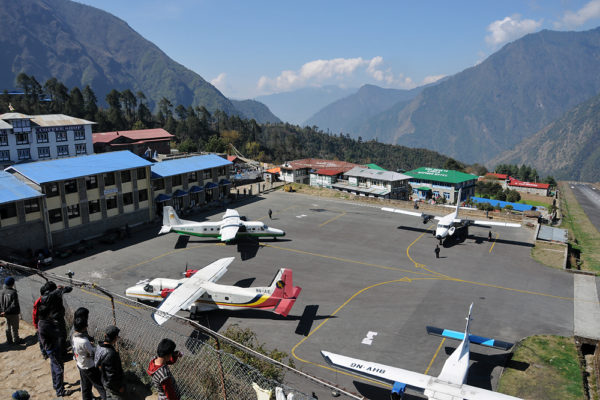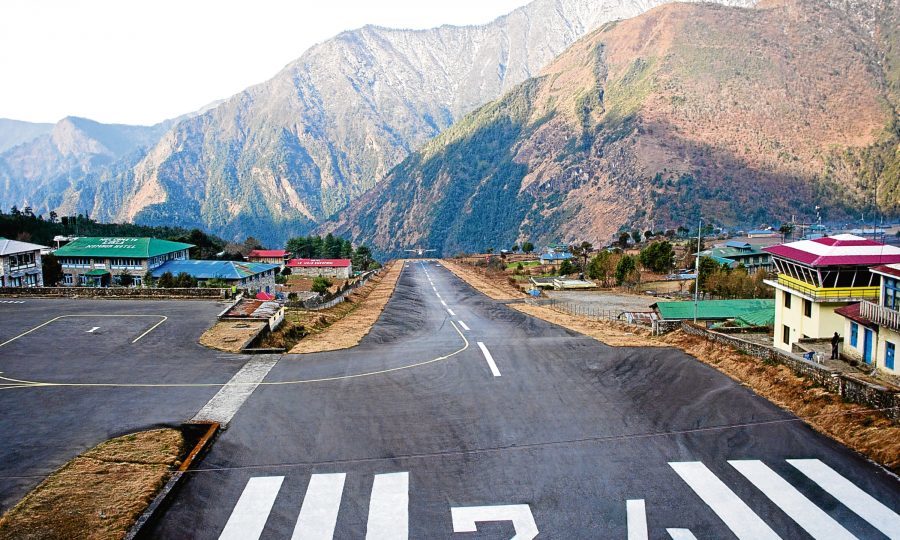
LUKLA AIRPORT- NEPAL: World's Scariest Airport/ Adventure of Mount Everest begins at tiny Nepal Strip
At Everest, it's not just the mountains that takes some guts, writes Plip Byrnes
There is one catch to arriving at the Everest Base Camp Trek start-point in Nepal and that is flying into infamous, perilous situated Lukla Airport.
That is the coolest airport ever. It going to be really, really exciting. Have fun!
Probably the most remote tourist destination in the world, the small town of Lukla, in the Khumbu region of Nepal, is a place that can only be reached by flights from Kathmandu, and other local airports. There is no road going into the town, and travelers to Lukla have to either fly in, or trek in from the nearest town with a road. Flights to Lukla land at the aptly-named Tenzing-Hillary Airport, which sits on the side of a mountain at an elevation of 2,860 meters.
Lukla Airport: Carved out of the side of mountains, the airport was built by Sir Edmund Hillary in 1965. At an altitude of 2,843 meters (9,325 feet) it is one of the most extreme and dangerous airport in the world.In January 2008 the airport was renamed Tenzing- Hillary Airportin in honour of Sir Edmund Hillary and Sherpa Tenzing Norgay, the first people to reach the summit of Mount Everest and also to make their efforts in the construction of this airport. Landing at Lukla airport in the outskirts of the Nepalese capital of Kathmandu is tricky. Just 1,500ft long and only 60ft wide, the runway ends in a blank mountain wall and has an uphill gradient of 12 per cent, in the town of Lukla, is a small airport in the town of Lukla in Khumbu, Solukhumbu district, Sagarmatha zone eastern Nepal.
Landing in Lukla leaves no room for error. Pilots throw their propellers into hard reverse before they touch down and gun the engines as they race down the hill for takeoff. Considering the extreme landscape it was the best candidate for the engineers to construct the facility. The strip is at an elevation of 2800 m with a an abrupt drop off down to a river valley below. The approach is through a maze of spectacular mountain peaks and the air is often cluttered with clouds.
There is a big hill right behind the landing strip. You also need to clear a high ridge, bank left, descend steeply, straighten the airplane and land. Navigation is by sight only and you need to negotiate several layers of clouds which can hang on the high hill or rise from the deep valley. This is why flights will often be cancelled and you could be stuck in Lukla waiting for a plane for days on end.
If this is worrying you one comforting thought is that only the most experienced pilots in Nepal are flying to Lukla.
 The airport is quite popular as Lukla is the place where most people start their trek to the Khumbu and Everest Base Camp and now what once was a dirt strip is one of Nepal's busiest domestic airport. Thousands of mountaineers and trekkers who visit the Everest Region have to fly to the airport if they want to avoid a day long bus trip from Kathmandu. In the peak season the airlines operate over 50 flights a day far beyond the acceptable capacity for such a facility.
The airport is quite popular as Lukla is the place where most people start their trek to the Khumbu and Everest Base Camp and now what once was a dirt strip is one of Nepal's busiest domestic airport. Thousands of mountaineers and trekkers who visit the Everest Region have to fly to the airport if they want to avoid a day long bus trip from Kathmandu. In the peak season the airlines operate over 50 flights a day far beyond the acceptable capacity for such a facility.
Lukla Airport: Carved out of the side of mountains, the airport was built by Sir Edmund Hillary in 1965. At an altitude of 2,843 meters (9,325 feet) it is one of the most extreme and dangerous airport in the world.In January 2008 the airport was renamed Tenzing- Hillary Airportin in honour of Sir Edmund Hillary and Sherpa Tenzing Norgay, the first people to reach the summit of Mount Everest and also to make their efforts in the construction of this airport. Landing at Lukla airport in the outskirts of the Nepalese capital of Kathmandu is tricky. Just 1,500ft long and only 60ft wide, the runway ends in a blank mountain wall and has an uphill gradient of 12 per cent, in the town of Lukla, is a small airport in the town of Lukla in Khumbu, Solukhumbu district, Sagarmatha zone eastern Nepal.
Why Lukla Airport is World's Most Dangerous Airport?
- Tenzing Hillary Airport doesn't have a Control Tower, Radar or Navigation.
- Pilots are forced to rely on the view from their Cockpit to Land and Take-Off.
- The 460 metre long runway-a tenth of standard length-is also on a slope.
- If a pilot misjudges landing or take-off, they face a 9,200 ft. fall off a cliff edge.
The landing strip is built on the steep incline of a hillside. Its length is 450 m and width 20 m. and the runway incline is a staggering 12%. The apron has 4 stands and there is one heli-pad located 150 m. below the air traffic control tower. No landing aids are available and Air Traffic Service is limited to AFIS (Aerodrome Flight Information Service) only.
There is a big hill right behind the landing strip. You also need to clear a high ridge, bank left, descend steeply, straighten the airplane and land. Navigation is by sight only and you need to negotiate several layers of clouds which can hang on the high hill or rise from the deep valley. This is why flights will often be cancelled and you could be stuck in Lukla waiting for a plane for days on end.
 The airport is quite popular as Lukla is the place where most people start their trek to the Khumbu and Everest Base Camp and now what once was a dirt strip is one of Nepal's busiest domestic airport. Thousands of mountaineers and trekkers who visit the Everest Region have to fly to the airport if they want to avoid a day long bus trip from Kathmandu. In the peak season the airlines operate over 50 flights a day far beyond the acceptable capacity for such a facility.
The airport is quite popular as Lukla is the place where most people start their trek to the Khumbu and Everest Base Camp and now what once was a dirt strip is one of Nepal's busiest domestic airport. Thousands of mountaineers and trekkers who visit the Everest Region have to fly to the airport if they want to avoid a day long bus trip from Kathmandu. In the peak season the airlines operate over 50 flights a day far beyond the acceptable capacity for such a facility.
The airport's paved Asphalt Runway (any of several black semisolid substances composed of bitumen and inert mineral matter. They occur naturally in parts of America and as a residue from petroleum distillation: used as a waterproofing material and in paints, dielectrics, and fungicides) is only accessible to helicopters and small, fixed-wing, short-take off and landing aircraft such as the De Havilland Canada DHC-6 Twin Otter, Derriere Do 228, and Pilates PC-6 Turbo Porter. The runway is one-way for both take off and landing. Aircraft have to land from the southwest and take-off toward the northeast because other end of one side of the runway is mountain. When winds are blowing in an unfavorable direction, all take off and landings have to stop.The runway is 460 by 20 m. ( 1,509 ft) with 12% gradient. The elevation of the airport is 2,800 m. (9,200 ft.)
Aircraft can only use Run-way 06 for Landing and Run-way 24 for Take-Off. There is no prospect of a successful go-around on short final due.
Trip Notes:
Flying into Lukla: Airlines flying into Lukla change annually, but Yeti Air, Tara Air ( a subsidiary of Yeti), Agni Air and Nepal Airlines are staples.
If travelling independently, have a local operators such as Himalayan Encounters can make reservations. They can arrange an experienced porter or guide to meet you at Lukla. Flights start at about $140 one way.
 In trekking season, flights can be booked solid. Try for earliest 6 am flights to avoid weather deterioration mid-morning (and cancelled flights). Be aware Lukla can close for days, but if pilots call it unsafe to fly, its best to go with the flow.
In trekking season, flights can be booked solid. Try for earliest 6 am flights to avoid weather deterioration mid-morning (and cancelled flights). Be aware Lukla can close for days, but if pilots call it unsafe to fly, its best to go with the flow.
Top Tip: Sit on the left-hand side of the plane towards Lukla for scenic Everest massive views, right side on the return.
The Control Towers: Manned
by two or three Air Traffic Controllers who are in constant Radio Contact with Kathmandu Airport and the Planes. They will decide if conditions are good enough for Plane to leave Kathmandu and land in
Lukla
Carved out of the side of a mountains-the Airport was built by Sir
Edmund Hillary in 1965 to help the local yak herders known as Sherpas
spur development in the improvised area. In picture Flight get ready to
take off
